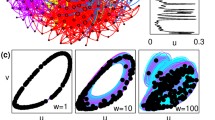Abstract
A globally coupled map lattice (GCML) is an extension of a spin glass model. It consists of a large number of maps with a high degree of nonlinearity, and evolves iteratively under averaging interactions via their mean field. It exhibits various interesting phases in the conflict between randomness and coherence. We have found that even in its weak coupling regime, the effects of the periodic windows of element maps dominate the dynamics of the system, and the system forms periodic cluster attractors. This may give a clue to efficient pattern recognition by the brain. We analyze how the effect systematically depends on the distance from the periodic windows in the parameter space.
Similar content being viewed by others
Explore related subjects
Discover the latest articles, news and stories from top researchers in related subjects.References
Kaneko K (1989) Chaotic but regular posi-nega switch among coded attractors by cluster-size variation. Phys Rev Lett 63:219–223
Kaneko K (1990) Globally coupled chaos violates the law of large numbers but not the central-limit theorem. Phys Rev Lett 65:1391–1394
Shibata T, Kaneko K (1998) Tongue-like bifurcation structures of the mean-field dynamics in a network of chaotic elements. Physica D 124:177–200
Shibata T, Kaneko K (1998) Collective chaos. Phys Rev Lett 81:4116–4119
Parravano AP, Cosenza MG (1999) Cluster dynamics in systems with constant mean field coupling. Int J Bifurcation Chaos 9:2311–2314
Shimada T, Kikuchi K (2000) Periodicity manifestations in the turbulent regime of the globally coupled map lattice. Phys Rev E62:3489–3503
Shimada T, Kikuchi K (2001) Periodic cluster attractors and their stabilities in the turbulent globally coupled map lattice. In: Prococeedings of the International Symposium on Artificial Life and Robotics, vol 2, pp 313–316
Shimada T, Tsukada S (2002) Periodicity manifestations in the non-locally coupled maps. Physica D 168–169:126–135
Perez G, Cerdeira HA (1992) Instabilities and nonstatistical behavior in globally coupled systems. Phys Rev A46:7492–7497
Metropolis N, Stein ML, Stein PR (1973) On finite limit sets for transformations on the unit interval. J Comb Theory A15:25–44
Kikuchi K, Shimada T (2002) Periodic window distribution in a one dimensional iterated map and its scaling relation. Trans JSCES, paper no. 20020005, pp 145–152
Author information
Authors and Affiliations
Corresponding author
Additional information
This work was presented in part at the 14th International Symposium on Artificial Life and Robotics, Oita, Japan, February 5–7, 2009
About this article
Cite this article
Shimada, T., Kubo, K. & Moriya, T. Synchronization and periodic windows in a globally coupled map lattice. Artif Life Robotics 14, 562–566 (2009). https://doi.org/10.1007/s10015-009-0744-4
Received:
Accepted:
Published:
Issue Date:
DOI: https://doi.org/10.1007/s10015-009-0744-4




